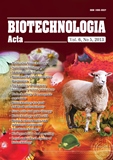ISSN 2410-776X (Online),
ISSN 2410-7751 (Print)

"Biotechnologia Acta" v. 6, no. 5, 2013
https://doi.org/10.15407/biotech6.05.087
Р.87-93, Bibliography13, Ukrainian
Universal Decimal classification: 602.1:53.082.9:615.099
DETERMINATION OF T-2 TOXIN BY THE IMMUNOENZYME AND IMMUNOSENSOR METHODS
О. S. Gojster1, W. Е. Kriwenchuk2, G. O. Chmelnitsky3, О. Н. Minchenko1
1Palladin Institute of Biochemistry of National Academy of Sciences of Ukraine, Kyiv
2Institute of Pharmacology and Toxicology of National Academy of Medical Sciences of Ukraine, Kyiv
3National University of Bioresources and Environmental Sciences of Ukraine, Kyiv
The aim of this work was the development of T-2 toxin immune-detection method using biosensor approaches. For this aim the conjugates of T-2 toxin with proteins were obtained and used for antibody preparation. The specific properties of obtained antibodies were studied by immunochemical methods. It was shown that carrier enzyme plays important role in realization of immunogenic properties of T-2 hapten. The detection time of IgG fraction as well as antiserum binding activity by immunoenzyme and immunosensor analyses is 10–15 minutes. Two variants of T-2 toxin determination in competitive mode of immunochemical analysis were suggested, i. e. ELISA and immunosensor method (based on surface plasmon resonance phenomenon) with detection from 10 ng/ml and 1 ng/ml, correspondingly. These methods can be applied for detection of T-2 toxin in the food and fodder in concentration from 1 up to 500 ng/ml.
Key words: T-2 toxin, conjugates, antibody, immune enzymatic analysis, immune biosensor.
© Palladin Institute of Biochemistry of National Academy of Sciences of Ukraine, 2013
References
1. Seeboth J., Solinhac R., Oswald I. P. The fungal T-2 toxin alters the activation of primary macrophages induced by TLR-agonists resulting in a decrease of the inflammatory response in the pig. Veter. Res. 2012, V. 43, Р. 35–45.
2. Busman M., Poling S. M., Maragos C. M. Observation of T-2 Toxin and HT-2 Toxin Glucosides from Fusarium sporotrichioides by Liquid Chromatography Coupled to Tandem Mass Spectrometry (LC-MS/MS). Toxins (Basel). 2011, 3 (12), 1554–1568.
3. Andreotti N., Hassine A. Peptide binding to ochratoxin A mycotoxin: a new approach in conception of biosensors. Biosens. Bioelectr. 2013, 40 (1), 240–246.
4. Li Y., Zhang Y., Shi W. Determination of T-2 toxin in milk: a comparison of three formats of immunoassays. Anal. Let. 2012, V. 45, P. 2425–2435.
5. Mitchell J. Small molecule іmmunosensing using surface plasmon resonance. А review. Sensors. 2010, 10 (8), 7323–7346.
6. Ad?nyia N., Levkovets I. A., Rodriguez-Gilc S. Development of immunosensor based on OWLS technique for determining Aflatoxin B1 and Ochratoxin A. Biosens. Bioelectr. 2007, 22 (6), 797–802.
7. Bryden W. L. Mycotoxin contamination of the feed supply chain: implication for animal productivity and feed security. Anim. Feed Sci. Technol. 2012, V. 173, P. 134–158.
8. Kotik A. N., Chernobai.V. T.., Komisarenko N. F., Trufanova V. A. Isolation of a mycotoxin Fusarium sporotrichioides and the study of its physical and chemical properties. Mikrobiol. zhurn. 1979, 41 (6), 636–639. (In Russian).
9. Grossman S., Mirocha C. J. Production of antibody against T-2 toxin. Appl. Environ. Microbiol. 1979, 73 (1), 104–108.
10. Antibodies. Methods. Ed. Ketti D. M. Мoskva: Mir. 1991, V. 1, 287 p. (In Russian).
11. Goister O. S., Khmelnitskii G. O., Dzyadevich S. V., Minchenko O. G. The influence of surface modification imunosensora sensitive to the effect of CPD to determine T-2 mycotoxin using poly- and monoclonal antibodies. Biotekhnologiia. 2009, 2 (2), 111–117. (In Ukrainian).
12. Kononenko G. P., Burkin A. A., Sobolova N. A., Zotova E. V. Immunoassay method for the determination of T-2 toxin in contaminated grains. Prikl. biokhim. mikrobiol. 1999, 35 (4), 457–462. (In Russian).
13. Whitaker T. B. Standartisation of mycotoxin sampling procedures: an urgent necessity. Food Contr. 2003, V. 14, P. 233–237.

